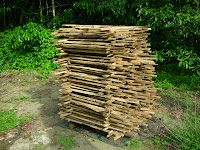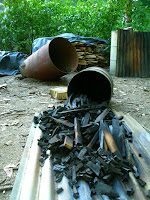
Moisture is the enemy. And waste biomass in Costa Rica's Osa Peninsula during the rainy season is nothing if not moist! To make matters worse, our feedstock of choice, Melina mill scrap, has a reputation in lumberman circles for persistent high moisture content. Moisture messes with you on several fronts: You have to drive it off before pyrolysis begins, so you consume more fuel wood (and time). We're using the same mill scrap for fuel wood, so the difficulty is compounded by smoky fires that are slow to get hot and require that much more wood to get the job done, resulting in that much more ash in the bottom of the fire chamber,

further confounding kiln performance. If that weren't enough, the volume of wood in the kiln retort (inner chamber that gets charred) is substantial enough so the outer portion (closest to the heat) has begun pyrolysis while the inner portion is still, quite literally, blowing off steam. The inevitable result is non-uniformity in the char, and frequently a high fraction that does not get charred at all.

We made a number of modifications to the kiln to improve its performance and accommodate the high-moisture fuel. These included more air intakes, a perforated kiln shelf to minimize ash blockage, corrugated roofing panels as thermal shields surrounding the kiln, and fitting the retort (inner drum) with a metal "diaper" to ease handling and minimize post-firing char burn. We also did our best to dry the scrap by sticker-stacking it and exposing it to the sun by day (running out in the middle of the night wearing nothing but our flip-flops to cover the stacks with plastic tarps if we get caught unawares by a tropical downpour!).

But the most important innovation we implemented was the afterburn. As described in my first can-can post, when pyrolysis begins, the fire really rips, promoting a positive feedback loop of heat-pyrolysis-combustion until (theoretically) all the pyrolysis gases have been driven off and you're left with nothing but char. Problem was, ours left us with a lot of wood, too. The inner portion of the load wasn't getting hot enough fast enough to "keep up" with the outer portion, because it had all that steam to blow off. So I implemented the afterburn:

After active pyrolysis winds down (no more roaring jet-engine-in-a-can), let it sit there being hot (driving off any remaining moisture) until the last embers in the bottom of the fire chamber have nearly burned out. Then re-load with fuel. This "second burning" takes a crack at the now-dry wood in the middle of the retort. You get a second coming of pyrolysis (jet-engine-in-a-can), though not quite as robust as the first. But when it's all done, you'll have nearly all char. (We never got 100% char, due to the fact that the "diaper" zone never sees the flame.)

We were ready to declare victory and proceed to a new kiln design when we were implored by the plant research group fraction in the project to make them some biochar for their field trials. A much larger kiln was under construction but was running behind schedule. Meanwhile, the plant research group had made commitments to graduate students from other institutions who were coming to Costa Rica for biochar thesis research. Plus, the growing season had begun and waiting longer could mess up an entire research season. So we made batch after batch of biochar using high-moisture-content Melina mill scrap in the inefficient can kiln.

How inefficient? An efficient kiln design should have a yield ratio of around 1:3; in other words you'll "sacrifice" (burn) about 1/3 of the wood volume as fuel for the 2/3 that gets turned to biochar. Given design limitations of the can-in-can kiln, at best it's probably a 1:1 proposition. With our high-moisture wood, we were running at 3:1 or worse, turning the yield ratio on its head. Not good. But they really needed biochar!







